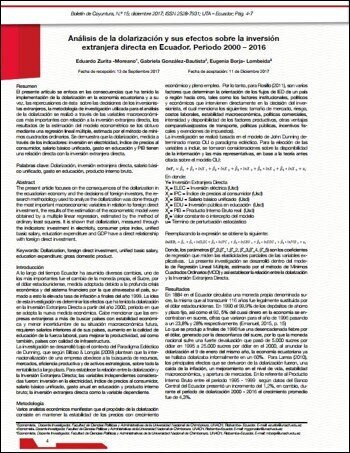Analysis of dollarization and its effects on foreign direct investment in Ecuador. Period 2000 - 2016
Main Article Content
Abstract
The present article focuses on the consequences of the dollarization in the ecuadorian economy and the decisions of foreign investors, the research methodology used to analyze the dollarization was done through the most important macroeconomic variables in relation to foreign direct investment, the results of the estimation of the econometric model were obtained by a multiple linear regression, estimated by the method of ordinary least squares. It is shown that dollarization, measured through the indicators: investment in electricity, consumer price index, unified basic salary, education expenditure and GDP have a direct relationship with foreign direct investment.
DOI: https://doi.org/10.31164/bcoyu.15.2017.652
URL: http://revistas.uta.edu.ec/erevista/index.php/bcoyu/article/view/652
Downloads
Article Details

This work is licensed under a Creative Commons Attribution-NonCommercial 4.0 International License.
![]()
The publications of the Boletín de Coyuntura are licensed under a Creative Commons Attribution-NonCommercial 4.0 International License (CC BY-NC 4.0). The Universidad Técnica de Ambato retains the copyright of the published works, and favors and allows the reuse of these, as long as: the authorship and original source of publication is cited, and they are not used for commercial or onerous purposes. The intellectual property of the published articles belongs to the authors.
References
Acosta, A. (18 de febrero de 2010). Zona económica. Obtenido de: http://www.zonaeconomica.com/ecuador/evolucion-inflacion/inflacion
Bilbao, J., & Longás, J. (2009). Temas de Economía Mundial. Madrid: Rumagraf.
De la Paz, M. (2013). Plan Maestro de Electrificación 2010-2020. Gestión, 38.
Emanuel, C. (21 de Julio de 2015). Repositorio de la Universidad de Especialidades Espíritu Santo. Obtenido de: http://www.uees.edu.ec/dolarizacion/pdf/3/6-Conf-Carlos-Julio-Emmanuel-210115.pdf
Guerrero, A. (2014). Informe Sectorial Ecuador: Sector Eléctrico. 30 de noviembre de 2014. Quito: ratingspcr.
Jiménez, J., Jiménez, M., & López, M. (17 de marzo de 2010). Comisión Económica para América Latina y el Caribe. Obtenido de: http://www.cepal.org/ilpes/noticias/paginas/1/41751/salinas_raho-na_salinas_doc.pdf
Larrea, C. (2008). Pobreza, dolarización y crisis en el Ecuador. Quito: Abya-Yala.
Ponce, J. (2010). Políticas educativas y desempeño: una evaluación de impacto de programas educativos. Quito: Rispergraf.
Rosillo. (26 de octubre de 2011). Universidad Politécnica Salesiana Sede Quito. Obtenido de http://dspace.ups.edu.ec/bitstream/123456789/4452/1/UPS-QT00055.pdf
Banco Central del Ecuador. (07 de 10 de 2016). Banco Central del Ecuador. Obtenido de https://contenido.bce.fin.ec/documen-tos/PublicacionesNotas/Notas/Dolarizacion/dolarizar.html
Comisión Económica para América Latina y el Caribe. Recuperado de: http://www.cepal.org/es
Instituto Nacional de Estadísticas y Censos (INEC). Recuperado de: http://www.ecuadorencifras.gob.ec/institucional/home/
Ministerio de Educación. Recuperado de: https://educacion.gob.ec/
Ministerio de Electricidad y Energía Renovable. Recuperado de: http://www.energia.gob.ec/
Secretaría Nacional de Educación Superior, Ciencia y Tecnología. Recuperado de: http://www.ces.gob.ec/index.php?option=com_sobi-pro&pid=390&sid=386:Eco-Rene-Ramirez-Gallegos&Itemid=424


